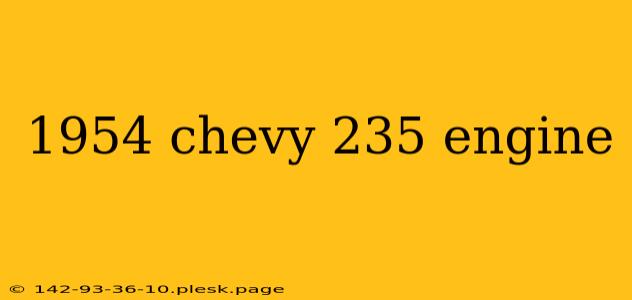The 1954 Chevrolet 235 cubic inch inline-six engine represents a pivotal moment in automotive history. This robust and reliable workhorse powered countless Chevrolet vehicles of the era, earning a reputation for longevity and ease of maintenance that continues to resonate with enthusiasts today. This deep dive explores the key features, specifications, and enduring appeal of this iconic engine.
Understanding the 1954 Chevy 235's Significance
The 235 engine, introduced in 1952, was a refinement of the Stovebolt six that preceded it. Its relatively simple design, using readily available parts, contributed to its widespread use and affordability. For 1954, key improvements solidified its place as a dependable powerplant. While not a powerhouse compared to modern engines, its torque characteristics made it ideal for the trucks and passenger cars it equipped. This made it a popular choice for both daily drivers and those seeking a reliable platform for customization.
Key Features and Specifications:
- Displacement: 235 cubic inches (3.8 liters)
- Configuration: Inline-six cylinder
- Valvetrain: Overhead Valve (OHV) - a significant advancement over the earlier flathead designs.
- Power Output: Around 115 horsepower, depending on the application. Note that horsepower figures from this era are often less precise than modern standards.
- Torque: The 235's substantial torque was a hallmark, providing ample pulling power for its intended uses.
- Casting Numbers: Identifying specific engine variations requires checking casting numbers on the engine block. These numbers provide information on the year, application, and specific internal components. Online resources and enthusiast forums are invaluable for decoding these numbers.
The Enduring Appeal of the 1954 Chevy 235
Even decades later, the 1954 Chevy 235 holds a special place in the hearts of car enthusiasts for several reasons:
- Simplicity and Maintainability: The relatively straightforward design makes the engine easy to work on, even for novice mechanics. Parts are still readily available, making restoration and maintenance relatively accessible.
- Reliability: Its reputation for reliability is well-earned. With proper care, these engines can last for decades.
- Adaptability: The 235's relatively compact size and robust design make it a popular choice for engine swaps in various classic and custom vehicles.
- Affordable Restoration: Compared to some other classic engines, parts for the 235 are often more affordable.
Common Modifications and Upgrades:
While the 235's stock configuration is reliable, many enthusiasts enjoy modifying them to enhance performance. Common upgrades include:
- Performance Camshafts: A performance camshaft can improve both horsepower and torque.
- Improved Intake and Exhaust Manifolds: Upgrading these systems can improve airflow and engine breathing.
- Carburetor Upgrades: High-performance carburetors can improve fuel delivery and overall engine performance.
- Ignition Upgrades: Modern ignition systems can provide more precise spark timing.
Conclusion: A Legacy of Reliability and Enthusiasm
The 1954 Chevrolet 235 engine stands as a testament to robust engineering and timeless design. Its combination of reliability, simplicity, and adaptability continues to attract enthusiasts who appreciate its classic appeal and potential for customization. Whether you're restoring a vintage Chevrolet or embarking on a custom project, the 235 offers a solid foundation for years of enjoyment. Remember to consult reputable resources and experienced mechanics for accurate information and safe practices when working with any classic engine.

